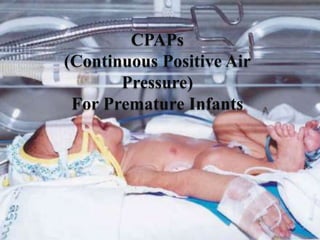
FINAL PRESENTATION
- 1. ) CPAPs (Continuous Positive Air Pressure) For Premature Infants
- 2. Outline Aim & objective Introduction History Physiology of Respiration Method & Material Other Ideas Failures of CPAPs Cost Evaluation References
- 3. Aims & Objective To reduce the cost User friendly Simplicity Minimizing the power consumption by giving power other then electrical source
- 4. Introduction CPAP (continuous positive airway pressure) is the; Mechanical mean to deliver positive air pressure Delivered by nasal prong or face mask Non-invasive technique Pt. breathes through mask against a continuous positive a/w pressure Can be delivered by either volume or pressure controlled ventilator Delivers set pressure with each breath, maintained throughout the respiratory cycle
- 5. Introduction(cont’d) CPAPs are used; For patients with breathing problems In case of sleep apnea Babies with immature lungs/ babies To maintain O2 concentration in blood mostly in premature babies To Prevents alveolar collapse during exhalation by maintaining a positive intra- alveolar pressure
- 6. Historical Background Von Reuss,German article,the disease of New born 1914, basic design of CPAPs First successful CPAP device, 1971 Dr. George Gregory(University of California, San Francisco) Prof.C.Sullivan (Royal Prince Alfred Hospital, Sydney, Australia,1981)
- 7. Physiology of Respiratory System
- 10. Graphical Representation Of Respiration
- 11. Methods & Materials Power source (other then electrical) DC Motor (to generate air flow) Air flow sensor( check air flow in cm H2O) Nasal prong (to attach with patient) Beaker with water & a graduated scale(in cm H2O) to control pressure according to lungs volume
- 12. Basic Flow Diagram Methods & Materials(cont’d) Power Source DC motor/ Fan Pressure r sensor Flow sensor circuit O/P To Patient
- 13. Methods & Materials (cont’d) Power source Solar Power (solar cells) photovoltaic effect (e transferred b/w d/f bands) Manual Power using dynamo using wheel using injection
- 14. Methods & Materials (cont’d) DC motor/fan 12 volts
- 15. Methods & Materials (cont’d) Pressure sensor convert air pressure into the voltage o/p voltage is directly prop. to the applied pressure
- 16. Pressure ranges according to their Use: Low Pressure 2-3 cmH2O Maintenance of lungVolume in very low birth weight infants During weaning Medium Pressure 4-7 cmH2O Increasing lung volume in surfactant deficiency Stabilizing areas of Atelectasis Stabilizing obstructive airway High pressure 8-10 cmH2O Preventing lungs Collapse with poor lung volume Improving distribution of ventilation Ultra High 11-14 cmH2O Tracheal or bronchial collapse In severe obstruction Reestablishing lung volume during ECHO
- 17. Methods & Materials (cont’d) Flow sensor circuit
- 18. Methods & Materials (cont’d) O/P to Patient Deliver supplemental airflow
- 19. Other Ideas A simple way to charge the battery is by using a small dynamo, turned by the DC Fan motor through a belt.
- 20. Failure Of CPAPs therapy in RDS Very low birth wt. infants Late application of CPAP Severity of RDS Associated disease e.g, sepsis, hypotension Infants with severe degree of extrapulmonary shunt
- 21. CPAPs in apnea of prematurity Decrease the incidence of apnea of prematurity (compared to other forms of stimulation) Improve oxygenation Stimulation or inhibition of pulmonary reflexes Alveolar stabilization Mechanical splinting of airway; reduce Supraglottic resistance in both inspiration and expiration Some investigators recommended the early use of CPAP as a preventive measure of apnea of prematurity
- 22. Adverse effect of CPAP Pulmonary air leak Type of CPAP Lung compliance Gestational age Gastric dilation and rupture Hypotension Increase pulmonary vascular resistance Chronic lung disease
- 23. Cost Evaluation Component Price in AUD$ DC Motor ~16.00$ Solar Panel ~40.00$ Rechargeable Battery ~ 25.00$ Tubing Giving by the hospital Nasal Prongs Giving by the hospital Flow Sensor ~34.00$ Air Detector Circuit ~12.00$ Other cost ~30.00$
- 24. Future prospects Research work almost have done Aware with basic anatomy & physiology Hardware will have to be implement Can do with some other new ideas
- 25. References Anonymous(21st Nov 2002) , “Obstetric Nursing” Avaliable:http://academic.cuesta.edu/atorrey/neo~comp. pdf Robert M. Ward*, Joanna C. Beach. (April 2003). “An International Journal of Obstetrics in Gynecology” pp8-16. Avaliable:http://onlinelibrary.wiley.com/doi/10.1046/j.1 471-0528.2003.00012.x/pdf Cheryl Morssette (7th June 2010), “CPAP”. Avaliable:http://preemies.about.com/od/glossaryintheni cu/g/CPAP.htm Anonymous (2006), “Sleep Disorders”, SA, Australia. Avaliable:http://www.sleepoz.org.au/files/fact_sheets/A T10%20-%20CPAP.pdf
- 26. References Anne Waugh, Allison Wynn Grant, Janet S. Ross. “Human Anatomy and Physiology in Health and Illness”, 9th Edition , Churchill Livingstone (15 July, 2001) Carol Dezateux* and Janet Stocks (2004) Vol. 63, “Lung development and early origins of childhood respiratory illness” Avaliable:http://bmb.oxfordjournals.org/content/53/1/40.full.pdf Sullivan C. E, Issa F,Berthon-Jones M and Eves L.(1981)” Reversal of obstructive sleep apnea by continuous positive airway pressure applied through the nares” Available: http://www.ncbi.nlm.nih.gov/pubmed/6112294?dopt=Abstract Dr.J.Rogers,(1999)”Cardiovasculor Physiology” Available: http://www.nda.ox.ac.uk/wfsa/html/u10/u1002_01.htm